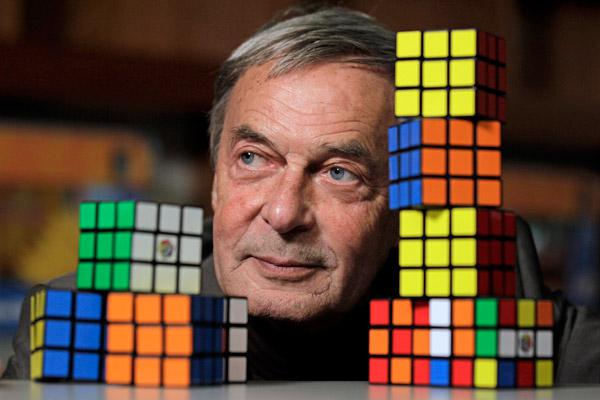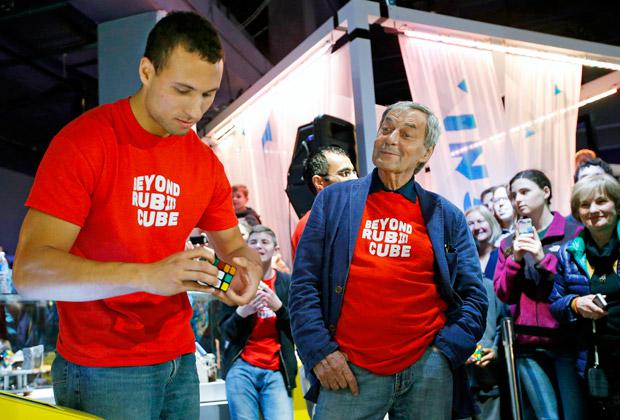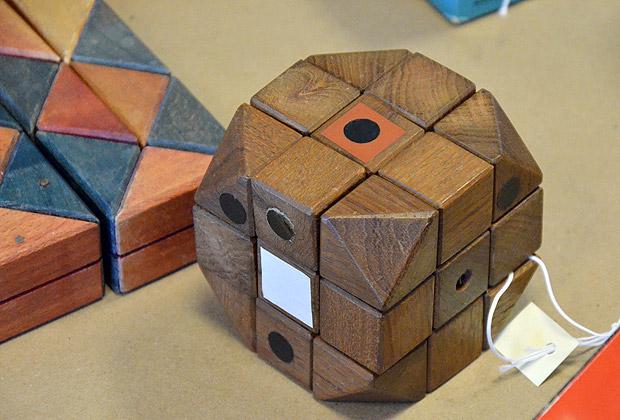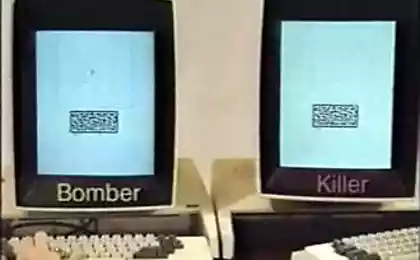1386
Three-dimensional visualizer defragmentation process
Five facts about the famous mechanical puzzle that you have forgotten.
Three-dimensional visualizer defragmentation process (in simple words - "cube-Rubik ') was invented in 1974 by Hungarian sculptor and professor of architecture Erno Rubik. Its first product he called the "Magic Cube" and did not expect that the toy will glorify the name of the inventor of the world.
Origin
There are several versions of the invention dice. Canonical is: thirty Professor Rubik has taught architecture at the Academy of Applied Arts and Crafts in Budapest. And, giving lectures on the mathematical theory of groups, wondered how to render this theory, so that students have learned the material better. Soon the tree was made cube model. And to see how the small cubes are moved by the rotation of faces Erne painted them in six different colors. During the rotation, they were mixed, and return the original appearance of the cube was not easy. Rubik himself with students and friends spent on solving a puzzle about a month.

Rubik's Cube is sweeping the planet
Cube immediately received worldwide recognition and popularity of the fantastic: it was literally everywhere, and even lying on the table in a cafe that interested persons could twist it. Few believed that collect the Rubik's cube possible. Because of the complexity of construction of the cube there was a set of anecdotes. There were those who thought the puzzle Hell, and the most unbalanced, they say, fell into a mental hospital, and not winning toy.
Then the cube began to study mathematics. Began appearing algorithms build complex and cumbersome at first, then more and more simple and accessible. Competitions were held for the assembly of the Rubik's Cube for speed, the first held in Budapest in 1982. Then record time - 22, 95 seconds showed 16-year-old student from Los Angeles Minh Thai. At present, the world record belongs to Dutchman Erik Akkersdiyku and is only 7 seconds.
Victory over the cube
On the Internet, there is a "Rubik's Cube Solution Center." There are discussed the model as a "win" the dice with a different number of faces - 3h3x3 and more. Schemes for beginners included. There is an official textbook "Assembling the Rubik's Cube," also describes the layered assembly algorithm. It is designed for beginners, there are the most simple combinations that still scare titles like "Step 2: Setting corner elements in the first layer." At best experts considered method, published in the 80s in the magazine "Young Technician". By the way, there are entire forums that discuss not only how to build, but also, for example, than the cube better lubricated (as skiers, it plays a crucial role in the rate).
Erno Rubik in competition on the occasion of the 40th anniversary of the puzzle in New Jersey, April 26, 2014
Photo: Eduardo Munoz / Reuters

Judgment of God
"God's algorithm" - such a great name is called optimal algorithm for solving the puzzle. The term appeared in relation to the Rubik's cube, but later began to be used for other "commuting" puzzles for which there is a minimum number of moves. This, for example, all the familiar tag. There is also the concept of "the number of God" - the smallest number of moves required to solve. "The number of God" to the Rubik's Cube with faces 3h3x3 equal to 20.
About the creator
Rubik's Cube changed the fate of the inventor. In the early 80's Erno Rubik became editor of games and puzzles, and founded his own studio, which developed puzzles and furniture design. Later Rubik opened Technical Academy, at which created an international fund to support especially talented young inventors. Rubik recent years has been developing video games and writes articles about architecture.
Following the Rubik's Cube has created no less popular "snake" and the play "Magic Ring". Engineer leaves inventive scope and now: a few years ago he designed another puzzle - "Rubik's Ball." But she did not get such glory as his first invention, made almost by accident.
©
here
You can comment.
Wooden prototype of the Rubik's Cube
Photo: Liberty Science Center

Three-dimensional visualizer defragmentation process (in simple words - "cube-Rubik ') was invented in 1974 by Hungarian sculptor and professor of architecture Erno Rubik. Its first product he called the "Magic Cube" and did not expect that the toy will glorify the name of the inventor of the world.
Origin
There are several versions of the invention dice. Canonical is: thirty Professor Rubik has taught architecture at the Academy of Applied Arts and Crafts in Budapest. And, giving lectures on the mathematical theory of groups, wondered how to render this theory, so that students have learned the material better. Soon the tree was made cube model. And to see how the small cubes are moved by the rotation of faces Erne painted them in six different colors. During the rotation, they were mixed, and return the original appearance of the cube was not easy. Rubik himself with students and friends spent on solving a puzzle about a month.

Rubik's Cube is sweeping the planet
Cube immediately received worldwide recognition and popularity of the fantastic: it was literally everywhere, and even lying on the table in a cafe that interested persons could twist it. Few believed that collect the Rubik's cube possible. Because of the complexity of construction of the cube there was a set of anecdotes. There were those who thought the puzzle Hell, and the most unbalanced, they say, fell into a mental hospital, and not winning toy.
Then the cube began to study mathematics. Began appearing algorithms build complex and cumbersome at first, then more and more simple and accessible. Competitions were held for the assembly of the Rubik's Cube for speed, the first held in Budapest in 1982. Then record time - 22, 95 seconds showed 16-year-old student from Los Angeles Minh Thai. At present, the world record belongs to Dutchman Erik Akkersdiyku and is only 7 seconds.
Victory over the cube
On the Internet, there is a "Rubik's Cube Solution Center." There are discussed the model as a "win" the dice with a different number of faces - 3h3x3 and more. Schemes for beginners included. There is an official textbook "Assembling the Rubik's Cube," also describes the layered assembly algorithm. It is designed for beginners, there are the most simple combinations that still scare titles like "Step 2: Setting corner elements in the first layer." At best experts considered method, published in the 80s in the magazine "Young Technician". By the way, there are entire forums that discuss not only how to build, but also, for example, than the cube better lubricated (as skiers, it plays a crucial role in the rate).
Erno Rubik in competition on the occasion of the 40th anniversary of the puzzle in New Jersey, April 26, 2014
Photo: Eduardo Munoz / Reuters

Judgment of God
"God's algorithm" - such a great name is called optimal algorithm for solving the puzzle. The term appeared in relation to the Rubik's cube, but later began to be used for other "commuting" puzzles for which there is a minimum number of moves. This, for example, all the familiar tag. There is also the concept of "the number of God" - the smallest number of moves required to solve. "The number of God" to the Rubik's Cube with faces 3h3x3 equal to 20.
About the creator
Rubik's Cube changed the fate of the inventor. In the early 80's Erno Rubik became editor of games and puzzles, and founded his own studio, which developed puzzles and furniture design. Later Rubik opened Technical Academy, at which created an international fund to support especially talented young inventors. Rubik recent years has been developing video games and writes articles about architecture.
Following the Rubik's Cube has created no less popular "snake" and the play "Magic Ring". Engineer leaves inventive scope and now: a few years ago he designed another puzzle - "Rubik's Ball." But she did not get such glory as his first invention, made almost by accident.
©
here
You can comment.
Wooden prototype of the Rubik's Cube
Photo: Liberty Science Center
























